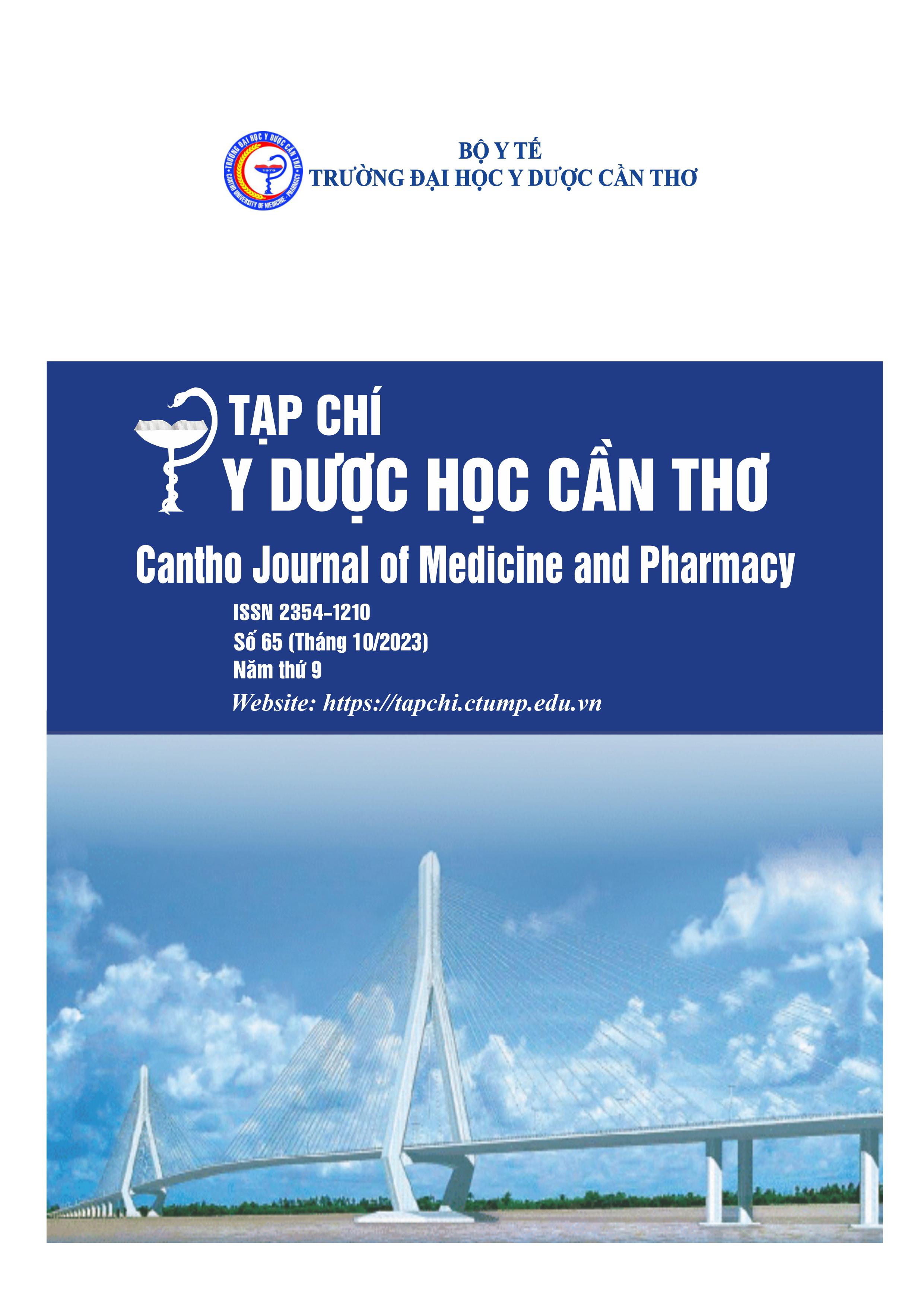THE PREVALENCE AND RELATED FACTORS OF FRAILTY IN ELDERLY PATIENTS WITH HYPERTENSION AT CA MAU GENERAL HOSPITAL IN 2022-2023
Main Article Content
Abstract
Background: Frail older adults are at risk for cognitive decline, injuries, dependence, increased treatment costs for underlying diseases, and even death if they are not promptly identified and managed, particularly those with comorbidities such as hypertension. Hypertension causes disability, decreased quality of life, and decreased mobility in older individuals, thereby aggravating the frailty condition. Objectives: To investigate specific characteristics, the prevalence of frailty, and factors related to frailty in elderly hypertensive patients admitted to Ca Mau General Hospital. Materials and methods: A prospective and cross-sectional investigation was conducted on 129 hypertensive patients aged 60 admitted to the Internal Medicine Department of Ca Mau General Hospital from 2022 to 2023. Results: The average age of the study participants was 72,6±8,6 years. In older patients with hypertension, the prevalence of frailty was considerable, accounting for 84.5%. Based on the Groningen Frailty Indicator questionnaire, advanced age, smoking, and comorbidities were found to be significantly associated with frailty, with p-values of 0.01, 0.03, and 0.001, respectively. Conclusions: The prevalence of frailty among elderly patients with hypertension was 84.5%, as measured by the Groningen Frailty Indicator questionnaire. The association between frailty and advanced age, smoking, and comorbidities was statistically significant.
Article Details
Keywords
Frailty, elderly patient, hypertension, Groningen Frailty Indicator, GFI
References
2. Hội tim mạch học Việt Nam. Khuyến cáo chẩn đoán và điều trị tăng huyết áp. 2018.
3. Dibello V., Zupo R., Sardone R., Lozupone M., Castellana F., et al. Oral frailty and its determinants in older age: a systematic review. Lancet Healthy Longev. Aug 2021. 2(8), 507520, https://doi.org/10.1016/S2666-7568(21)00143-4.
4. Nguyễn Ngọc Mai Phương, Tăng Thị Thu, Võ Yến Nhi, Thân Hà Ngọc Thể, Nguyễn Ngọc Hoành Mỹ Tiên và cộng sự. Tỉ lệ suy yếu ở người cao tuổi điều trị tại các khoa Nội bệnh viện Đại học Y dược Thành phố Hồ Chí Minh theo bộ câu hỏi Groningen, mối liên quan giữa một số đặc điểm lâm sàng và nhân khẩu học suy yếu. Tạp chí Y học TP Hồ Chí Minh. 2018. 22(1), 296-302.
5. Huang E.Y.Z., Cheung J., Liu J.Y.W., Kwan R.Y.C., Lam S.C. Groningen Frailty IndicatorChinese (GFI-C) for pre-frailty and frailty assessment among older people living in communities: psychometric properties and diagnostic accuracy. BMC Geriatr. Oct 7 2022. 22(1), 788, https://doi.org/10.1186/s12877-022-03437-1.
6. Aprahamian I., Sassaki E., Dos Santos M.F., Izbicki R., Pulgrossi R.C., et al. Hypertension and frailty in older adults. J Clin Hypertens (Greenwich). Jan 2018. 20(1), 186-192, https://doi.org/10.1111/jch.13135.
7. Siriwardhana D.D., Hardoon S., Rait G. Weerasinghe M.C., Walters K.R. Prevalence of frailty and prefrailty among community-dwelling older adults in low-income and middleincome countries: a systematic review and meta-analysis. BMJ Open. 2018. 8 (3), e018195, https://doi.org/10.1136/bmjopen-2017-018195.
8. Nguyễn Ngọc Hoành Mỹ Tiên, Thân Hà Ngọc Thể, Nguyễn Thị An. Khảo sát tỷ lệ suy yếu và mối liên quan giữa suy yếu với kết cục lâm sàng ngắn hạn ở bệnh nhân cao tuổi điều trị nội trú tại Bệnh viện Bà Rịa. Tạp chí Y học TP Hồ Chí Minh. 2019. 23(2), 9-14.
9. Andrade J.M., Duarte Y.A.O., Alves L.C., Andrade F.C.D., Souza Junior P.R.B., et al. Frailty profile in Brazilian older adults: ELSI-Brazil. Rev Saude Publica. Oct 25 2018. 52 (2), 17, https://doi.org/10.11606/S1518-8787.2018052000616.
10. Li Y., Liu M., Miyawaki C.E. Sun X., Hou T., et al. Bidirectional relationship between subjective age and frailty: a prospective cohort study. BMC Geriatrics. 2021. 21(1), 395, https://doi.org/10.1186/s12877-021-02344-1.
11. Fu Z., Zhou T., Dong F., Li M., Lin X., et al. Secondhand smoke is positively associated with pre-frailty and frailty in non-smoking older adults. Front Psychiatry. 2022. 13, 1095254, https://doi.org/10.3389/fpsyt.2022.1095254.
12. Fried L.P., Tangen C.M., Walston J., Newman A.B., Hirsch C., et al. Frailty in older adults:
evidence for a phenotype. J Gerontol A Biol Sci Med Sci. Mar 2001. 56(3), M146-56, https://doi.org/10.1093/gerona/56.3.m146.
13. Gale C.R., Baylis D., Cooper C., Sayer A.A. Inflammatory markers and incident frailty in men and women: the English Longitudinal Study of Ageing. Age (Dordr). Dec 2013. 35(6), 2493501, https://doi.org/10.1007/s11357-013-9528-9.
14. Espinoza S.E., Quiben M., Hazuda H.P. Distinguishing Comorbidity, Disability, and Frailty. Curr Geriatr Rep. 2018. 7(4), 201-209, https://doi.org/10.1007/s13670-018-0254-0.


